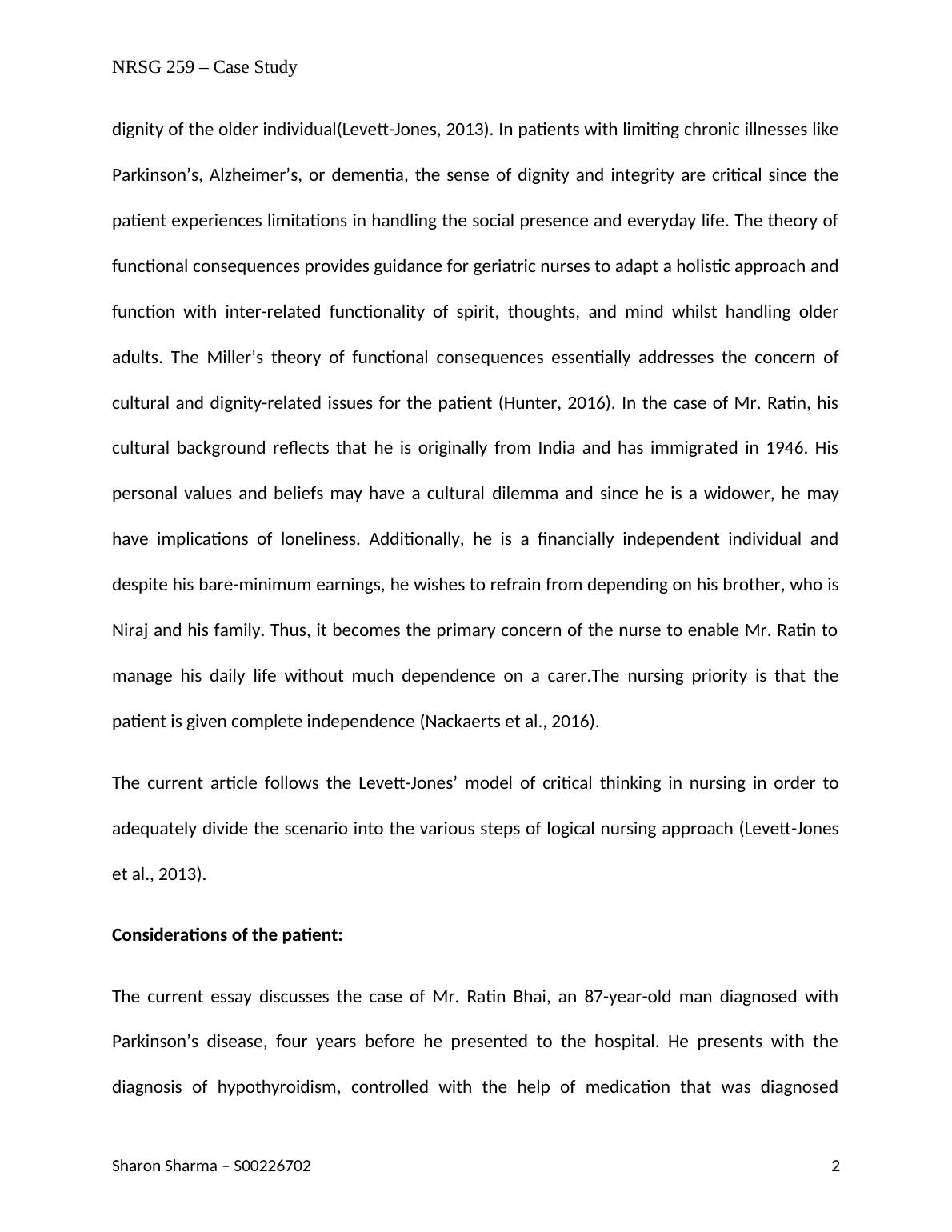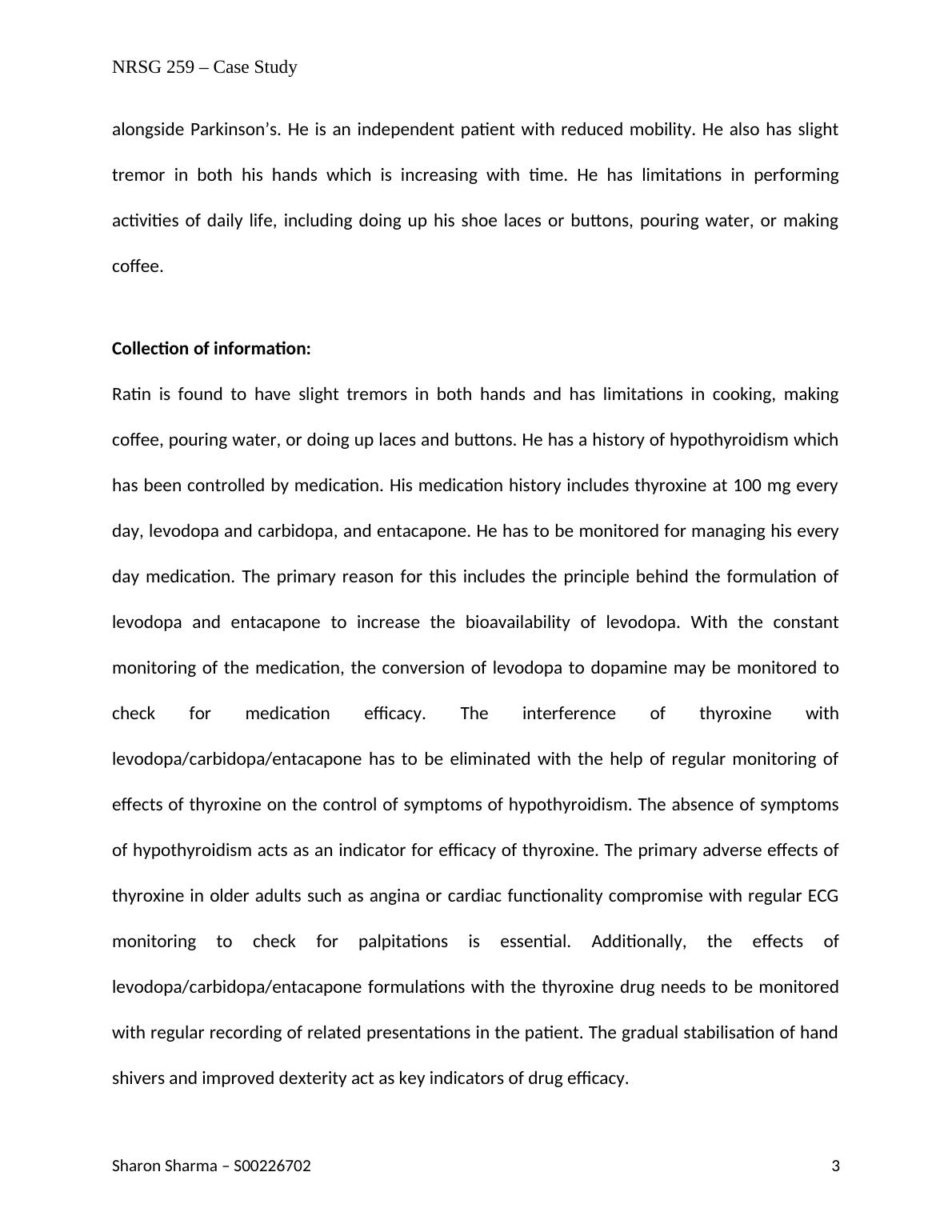Nursing Care Priorities For a Patient With Parkinson’s Disease
Added on 2020-03-04
12 Pages3155 Words455 Views
NRSG 259 – Case StudyNursing care priorities for a patient with Parkinson’s diseaseThe primary goal of this essay is to identify the nursing care needs of a particular patient anddiscussing the priorities of nursing care for that patient. The essay has a background of twoimportant functional theories: The Miller’s functional consequences theory that helps in theidentification of the various factors that impact the elderly patient and theeffect of theseinfluencing factors. Additionally, the essay explores the eight steps of reasoning and criticalthinking in nursing using the Levett-Jones’ theory of clinical reasoning.Part A:Geriatric nursing involves several considerations that include the social and the lifestyleconcerns of the patient (Hunter, 2016). Critical thinking and logical approach to nursing in olderpatients are essential in order to maintain the dignity and the interest of the patient (McMahon&Fleury, 2012). Wellness of the patients is regarded a primary consideration in nursing.Specifically, in cases of Parkinson’s disease, where limitations are imposed upon the daily lifeactivities of the elderly patient, the protection of patient wellness is of critical importance(McMahon & Fleury, 2012).The Miller’s theory of functional consequences provides an essential framework for theunderstanding of promotion of wellness in older adults. This theory provides a basic frameworkfor nurses for the identification of the potential of an individual for the growth of the personand the utilisation of diagnoses in nursing in order to provide the sense of value and protect theSharon Sharma – S002267021

NRSG 259 – Case Studydignity of the older individual(Levett-Jones, 2013). In patients with limiting chronic illnesses likeParkinson’s, Alzheimer’s, or dementia, the sense of dignity and integrity are critical since thepatient experiences limitations in handling the social presence and everyday life. The theory offunctional consequences provides guidance for geriatric nurses to adapt a holistic approach andfunction with inter-related functionality of spirit, thoughts, and mind whilst handling olderadults. The Miller’s theory of functional consequences essentially addresses the concern ofcultural and dignity-related issues for the patient (Hunter, 2016). In the case of Mr. Ratin, hiscultural background reflects that he is originally from India and has immigrated in 1946. Hispersonal values and beliefs may have a cultural dilemma and since he is a widower, he mayhave implications of loneliness. Additionally, he is a financially independent individual anddespite his bare-minimum earnings, he wishes to refrain from depending on his brother, who isNiraj and his family. Thus, it becomes the primary concern of the nurse to enable Mr. Ratin tomanage his daily life without much dependence on a carer.The nursing priority is that thepatient is given complete independence (Nackaerts et al., 2016).The current article follows the Levett-Jones’ model of critical thinking in nursing in order toadequately divide the scenario into the various steps of logical nursing approach (Levett-Joneset al., 2013).Considerations of the patient:The current essay discusses the case of Mr. Ratin Bhai, an 87-year-old man diagnosed withParkinson’s disease, four years before he presented to the hospital. He presents with thediagnosis of hypothyroidism, controlled with the help of medication that was diagnosedSharon Sharma – S002267022

NRSG 259 – Case Studyalongside Parkinson’s. He is an independent patient with reduced mobility. He also has slighttremor in both his hands which is increasing with time. He has limitations in performingactivities of daily life, including doing up his shoe laces or buttons, pouring water, or makingcoffee. Collection of information:Ratin is found to have slight tremors in both hands and has limitations in cooking, makingcoffee, pouring water, or doing up laces and buttons. He has a history of hypothyroidism whichhas been controlled by medication. His medication history includes thyroxine at 100 mg everyday, levodopa and carbidopa, and entacapone. He has to be monitored for managing his everyday medication. The primary reason for this includes the principle behind the formulation oflevodopa and entacapone to increase the bioavailability of levodopa. With the constantmonitoring of the medication, the conversion of levodopa to dopamine may be monitored tocheck for medication efficacy. The interference of thyroxine withlevodopa/carbidopa/entacapone has to be eliminated with the help of regular monitoring ofeffects of thyroxine on the control of symptoms of hypothyroidism. The absence of symptomsof hypothyroidism acts as an indicator for efficacy of thyroxine. The primary adverse effects ofthyroxine in older adults such as angina or cardiac functionality compromise with regular ECGmonitoring to check for palpitations is essential. Additionally, the effects oflevodopa/carbidopa/entacapone formulations with the thyroxine drug needs to be monitoredwith regular recording of related presentations in the patient. The gradual stabilisation of handshivers and improved dexterity act as key indicators of drug efficacy.Sharon Sharma – S002267023

NRSG 259 – Case StudyProcessing the obtained information:The patient is receiving levothyroxine treatment for hypothyroidism. The drug has a half-life ofabout 7 days with dosage on a daily basis (Costa, Rosso, &Maultasch, 2012). In the elderly, thedosage requirements of levothyroxine decrease. The primary reason for this is the decline inthe degradation of levothyroxine that occurs with age. High dosages of thyroxine in the elderlymay lead to the catalysis of myocardial infarction and angina in the older patients (Lambrinou,Kalogirou,Lamnisos,&Sourtzi,2012). Several dietary supplements and medications can adverselyaffect or cause interference to the action of levothyroxine. Supplements of iron, aluminium,cholestyramine, and calcium can intervene with the effects of thyroxine.Additionally, in the elderly who take levothyroxine treatments, there can be the presence ofinterference with the activities of daily life.The dosage of thyroxine has to be significantlyreduced in older adults (Nackaerts et al., 2016). Mr. Ratin presents with tremors and due tothis, he has several limitations in performing activities of daily life such as cooking and similaractivities (Nackaerts et al., 2016). Thyroxine can have adverse effects on the tremors and canlead to the enhancement of the tremors (Kong, Qin, Zhou, Mou, & Gao, 2014).Identification of the specific problems:In order to specifically identify the problems that Mr. Ratin has, it is essential to reflect uponthe issues presented in literature about Parkinson’s disease and the current approach oftreatment of the disease.Parkinson’s disease is typically characterised by chronic andprogressive neurodegenerative events (Tolosa et al., 2014). Parkinson’s disease is traditionallyperceived as a disease of motor functions and results in cardinal symptoms and leads toSharon Sharma – S002267024

End of preview
Want to access all the pages? Upload your documents or become a member.
Related Documents
Nursing Priorities using Clinical Reasoning Modellg...
|11
|2961
|98
Assessment Task 1 – Care Planninglg...
|10
|2577
|352
Promoting Health in Extended Carelg...
|9
|2615
|47
Nursing Care - Individual discussion | Assignmentlg...
|9
|2584
|185
Nursing Assignment: Case Study of Amalie Joneslg...
|11
|3064
|473
NRSG259 Promoting Health in Extended Care Assignmentlg...
|11
|2761
|249